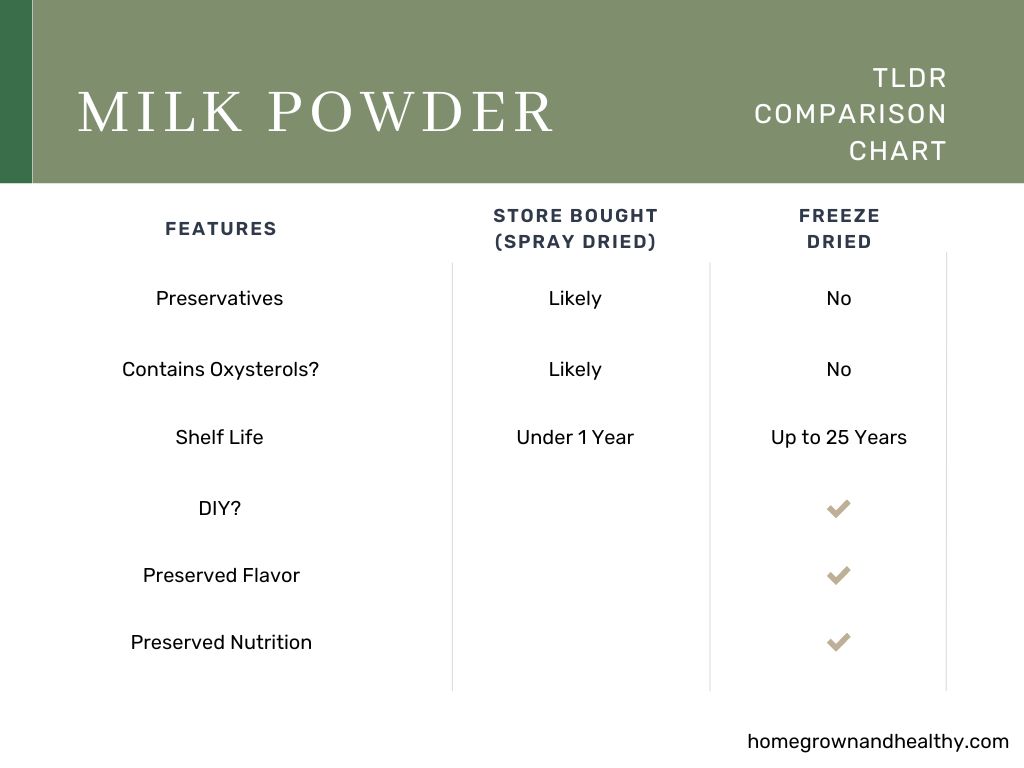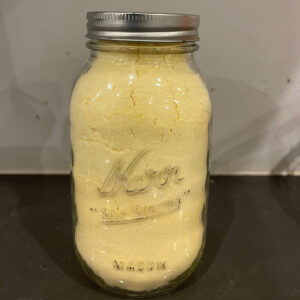Milk is one of the easiest, best, and most cost effective foods to freeze dry at home. Once your milk has been freeze dried and powdered, it’s very lightweight, it can be stored in the proper conditions for up to 25 years, an entire gallon of powdered milk will fit in a quart jar, and powdered milk can be easily reconstituted with water back to its original form.

How Long Does Freeze Dried Milk Last?
Freeze-dried milk has an incredibly long shelf life of up to 25 years. Freeze dried non-fat (skim) milk stored properly can last for 25 years while whole milk will not last as long. The difference is the fat content and the fact that it is harder for the freeze drying process to remove as much water from the fattier whole milk.
To maximize storage time, it’s best to store the freeze dried, powdered milk in a light proof container (like a Mylar bag) in a cool area with a sufficiently sized oxygen scavenger, typically 300cc.

Can You Freeze Dry Store Bought Milk?
Store bought milk is ideal to freeze dry because of the numerous options available as far as fat content. If you want a fattier option that may have a shorter shelf life, you can go with whole milk. If you want something to store longer term for emergencies (or otherwise), you can go with your favorite store brand of skim milk.
What Other Dairy Products Can You Freeze Dry?
Besides milk, yogurt, Greek yogurt, cream, sour cream, cheese, and our favorite, ice cream, can all be freeze dried. Milk and Greek yogurt make great additions to recipes for flavor or protein. Ice cream and Greek yogurt are great in small dollops for snacks and quick treats on the go.
Is Freeze Dried Milk the Same as Powdered Milk?
Powdered milk typically purchased at the store is produced by spray drying whereas freeze dried milk is frozen, then placed under a vacuum to sublimate the water into a gas to be removed.
In the process of spray drying, milk is placed into an evaporator to remove a portion of the contained water, then it is sprayed into a heated chamber in which the water will quickly evaporate and leave only powder. This process is faster than freeze drying and allows for the production of more powdered milk during the same time period, however, in the heating process, some of the nutritional content of the milk will be lost.
Additionally, commercially produced, spray dried, powdered milk is suspected to contain oxysterols (oxidized cholesterol) that may be detrimental to heart health.(1)
Though the amount of freeze dried milk that a consumer can produce at home is limited to a freeze drying cycle and the size of the freeze dryer, the final, finished product has clear benefits over commercially produced, spray dried powdered milk.
Can You Store Powdered Milk in Mason Jars?
A mason jar is a good choice for storing powdered milk that you’ve freeze dried. However, you must keep in mind that the milk should be protected from light to maximize the shelf life of the milk and preserve nutritional content.
Additionally, you’ll want to avoid removing the top too many times or leaving it off for an extended period of time. The longer the top is off, the more moisture will absorb into the milk and the sooner the powdered milk will spoil. A sealed Mylar bag with an oxygen scavenger will allow for the longest storage time.

Why Does Powdered Milk Taste Different?
Store bought powdered milk that has been produced by spray drying tastes different after reconstituting than normal store bought milk because of the heating process needed to produce the powdered milk. Because of the heat, some of the flavor, texture and nutritional value of the product is lost and make for a finished product that is not the same as the original.
Additionally, some powdered milk producers may add flavorings, colors, or other additives to their powdered milk in order to make it taste more like the original product. As a result, the taste of powdered milk may be slightly different than regular or freeze-dried milk.
Additionally, if not stored properly, powdered milk may also quickly spoil and become stale which will affect its taste.
Lastly, the water used to reconstitute the milk will make a difference in the final flavor. Well water may add some mineral flavors that reverse osmosis filtered water would not, and city water from city to city has much different flavor.
How Long Does Dry Milk Powder Last?
Store bought dry milk powder typically has a shelf life of up to nine months if stored in an airtight container in a cool, dry place. The milk powder should not be exposed to any direct sunlight or extreme temperatures or it may spoil more quickly.
Once opened, however, the shelf life of dry milk powder may be significantly reduced and can only last for up to two weeks when stored properly. It will begin to absorb moisture as soon as the airtight seal has been broken.
To ensure the best quality and taste, it is important to check the expiration date on the packaging before purchasing any dry milk powder and try to use it within its suggested shelf life
How Can I tell if Milk Powder is Spoiled?
You’ll be able to tell if milk powder has spoiled if it develops an off yellow color or a strange odor. Moisture is the biggest culprit for spoilage so the milk powder may also start to form clumps. If you’ve stored the milk powder in something like a mason jar that doesn’t protect it from light, sunlight (UV radiation) may also destroy the nutritional value of the milk powder before the container is even opened.
Conclusion
Which is better; store bought dried milk powder or freeze dried milk powder? We think the answer is clear, if you can make or buy freeze dried milk powder, this is the preferred option. With preserved flavor and nutrition, no added chemicals, much longer shelf life, and control of the source, freeze dried milk powder checks all of the boxes and is the preferred option for long term milk storage.
(1) 655 in “Advanced Dairy Chemistry: Volume 2 – Lipids” by P.F. Fox and P. McSweeney, Birkhäuser, 2006 ISBN 978-0-387-26364-9
